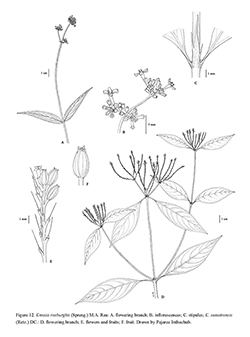e-Flora of Thailand
Volume 15 > Part 1 > Year 2021 > Page 81 > Rubiaceae > Knoxia
3. Knoxia sumatrensis (Retz.) DC.wfo-0000221148
Prodr. 4: 569. 1830; R.Bhattacharjee & Deb, J. Econ. Tax. Bot. 6: 89. 1985; Tao Chen & C.M.Taylor in Z.Y.Wu et al., Fl. China 19: 185. 2011; Chantar. & Puff, Trop. Nat. Hist. 16: 62. 2016.— Spermacoce sumatrensis Retz., Observ. Bot. 4: 23. 1786. Fig. 12D–F.
Accepted Name : This is currently accepted.
Synonyms & Citations :
Description : Subshrubby perennials to 1 m tall; stems often branched, sparsely to densely tomentose above, glabrescent below. Stipules 0.3–1(–1.5) cm long, with typically 4–6 bristles, 0.5–1 cm long. Leaves oblong- or ovate-lanceolate, 4–10 by 1–4 cm, base acute to attenuate or obtuse, apex acute to acuminate, sparsely pubescent above, pubescent beneath, particularly on veins, lateral veins 5–12 pairs; petiole (0.5–)1–2(– 3) cm long. Inflorescences thyrso-paniculate, often corymbiform and rather lax; cymes much elongating in fruit; peduncle 2–7(–10) cm long. Flowers shortly pedicellate to subsessile (but pedicels elongating up to ca 2 mm in fruit). Calyx slightly unequal, 1 lobe to ca 0.7 mm long, the others < 0.5 mm. Corolla white, yellowish white, pinkish white, pale rose, pale lilac or pale blue-violet, glabrous outside; tube 2–6 mm long, pubescent inside at least around throat, cylindrical in short-styled and widened above in long-styled morph; lobes 1–3 mm long. Stamens 2–4 mm long and exserted in short-styled morph, included in widened upper corolla tube portion and 1.5–2 mm in long-styled morph; anthers 0.5–1 mm. Ovary to 1.5 mm high, ovoid to oblong; style exserted and 0.5–1 cm long in long-styled morph, included and 1–5 mm long in short-styled morph; stigma lobes ca 0.5 mm long. Fruits greyish to dark brown, faintly to conspicuously quadrangular, 1–3 by 0.8–2.4 mm; mericarps often remaining (partially) united, leaving behind column-like, apically 2-forked carpophore, sometimes splitting from base into 2 one-seeded units.
Thailand : NORTHERN: Chiang Mai, Chiang Rai, Lamphun, Phrae, Kamphaeng Phet; NORTH-EASTERN: Loei, Khon Kaen, Sakon Nakhon, Mukdahan; EASTERN: Nakhon Ratchasima; SOUTH-WESTERN: Kanchanaburi, Ratchaburi, Phetchaburi; CENTRAL: Saraburi; SOUTH-EASTERN: Prachin Buri; PENINSULAR: Chumphon.
Distribution : In continental SE Asia from India to China, Cambodia and Vietnam, Taiwan, in Malesia from Peninsular Malaysia, Sumatra (type) to New Guinea and Australia (Queensland).
Ecology : Pine-oak forests, dry dipterocarp forests, open deciduous forests, seasonal rain forests, lower montane rain forests. Usually growing in undisturbed or disturbed open (grassy) areas on sandy to rocky ground, sometimes over limestone, 10–1,700 m alt. Flowering and fruiting: May–November (fruiting to January).
Vernacular : Tong lai (ตองลาย)(Chiang Rai); ma khok taek (ม้าคอกแตก), hak mahan (ฮักมะหาน)(Chiang Mai).

